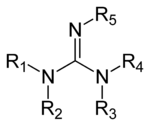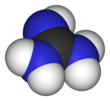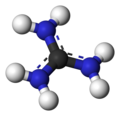Guanidine
| |||
| |||
| Names | |||
|---|---|---|---|
| Preferred IUPAC name
Guanidine[1] | |||
| Other names
Iminomethanediamine
| |||
| Identifiers | |||
3D model (JSmol)
|
|||
| 506044 | |||
| ChEBI | |||
| ChEMBL | |||
| ChemSpider | |||
| DrugBank | |||
| ECHA InfoCard | 100.003.656 | ||
| EC Number |
| ||
| 100679 | |||
| MeSH | Guanidine | ||
PubChemCID
|
|||
| UNII | |||
CompTox Dashboard(EPA)
|
|||
| |||
| |||
| Properties | |||
| CH5N3 | |||
| Molar mass | 59.072g·mol−1 | ||
| Melting point | 50 °C (122 °F; 323 K) | ||
| logP | −1.251 | ||
| Conjugate acid | Guanidinium | ||
| Thermochemistry | |||
Std enthalpy of
formation(ΔfH⦵298) |
−57 – −55 kJ mol−1 | ||
Std enthalpy of
combustion(ΔcH⦵298) |
−1.0511 – −1.0531 MJ mol−1 | ||
| Pharmacology | |||
| Pharmacokinetics: | |||
| 7–8 hours | |||
| Hazards | |||
| Lethal doseor concentration (LD, LC): | |||
LD50(median dose)
|
475 mg/kg (oral, rat)[2] | ||
| Related compounds | |||
Related compounds
|
|||
Except where otherwise noted, data are given for materials in theirstandard state(at 25 °C [77 °F], 100 kPa).
| |||
Guanidineis the compound with the formula HNC(NH2)2.It is a colourless solid that dissolves inpolarsolvents. It is astrong basethat is used in the production ofplasticsandexplosives.It is found inurinepredominantly in patients experiencing renal failure.[3]A guanidinemoietyalso appears in larger organic molecules, including on the side chain ofarginine.
Structure[edit]
Guanidine can be thought of as a nitrogenous analogue ofcarbonic acid.That is, the C=O group in carbonic acid is replaced by a C=NH group, and each OH is replaced by aNH
2group.[4]Isobutenecan be seen as the carbon analogue in much the same way. A detailed crystallographic analysis of guanidine was elucidated 148 years after its first synthesis, despite the simplicity of the molecule.[5]In 2013, the positions of the hydrogen atoms and their displacement parameters were accurately determined using single-crystal neutron diffraction.[6]
Production[edit]
Guanidine can be obtained from natural sources, being first isolated in 1861 byAdolph Streckervia the oxidative degradation of an aromatic natural product,guanine,isolated from Peruvianguano.[7][8]
A laboratory method of producing guanidine is gentle (180-190 °C) thermal decomposition of dryammonium thiocyanatein anhydrous conditions:
The commercial route involves a two step process starting with the reaction ofdicyandiamidewithammoniumsalts. Via the intermediacy ofbiguanidine,thisammonolysisstep affords salts of the guanidinium cation (see below). In the second step, the salt is treated with base, such assodium methoxide.[7]
Chemistry[edit]
Guanidinium cation[edit]
Theconjugate acidis called theguanidiniumcation,(C(NH
2)+
3). This planar, symmetric ion consists of threeaminogroups each bonded to the central carbon atom with a covalent bond oforder4/3. It is a highly stable+1cation in aqueous solution due to the efficientresonance stabilizationof the charge and efficientsolvationby water molecules. As a result, itspKaHis 13.6[9](pKbof 0.4) meaning that guanidine is a very strong base in water; in neutral water, it exists almost exclusively as guanidinium. Due to this, most guanidine derivatives are salts containing the conjugate acid.
-
canonical forms
Testing for guanidine[edit]
Guanidine can be selectively detected using sodium 1,2-naphthoquinone-4-sulfonic acid (Folin's reagent) and acidified urea.[10]
Uses[edit]
Industry[edit]
The main salt of commercial interest isthe nitrate[C(NH
2)3]NO
3.It is used as a propellant, for example inair bags.
Medicine[edit]
Since the Middle Ages in Europe, guanidine has been used to treat diabetes as the activeantihyperglycemicingredient inFrench lilac.Due to its long-termhepatotoxicity,further research for blood sugar control was suspended at first after the discovery of insulin. Later development of nontoxic, safebiguanidesled to the long-used first-line diabetes control medicinemetformin,introduced to Europe in the 1950s & United States in 1995 and now prescribed to over 17 million patients per year in the US.[11][12]
Guanidinium chloride[11]is a now-controversialadjuvantin treatment ofbotulism.Recent studies have shown some significant subsets of patients who see no improvement after the administration of this drug.[13]
Biochemistry[edit]
Guanidine exists protonated, as guanidinium, in solution at physiological pH.
Guanidinium chloride(also known as guanidine hydrochloride) haschaotropicproperties and is used to denature proteins. Guanidinium chloride is known to denature proteins with a linear relationship between concentration andfree energyof unfolding. In aqueous solutions containing 6Mguanidinium chloride, almost allproteinslose their entiresecondary structureand becomerandomly coiledpeptide chains.Guanidinium thiocyanateis also used for its denaturing effect on various biological samples.
Recent studies suggest that guanidinium is produced by bacteria as a toxic byproduct. To alleviate the toxicity of guanidinium, bacteria have developed a class of transporters known as guanidinium exporters or Gdx proteins to expel the extra amounts of this ion to the outside of the cell.[14]Gdx proteins, are highly selective for guanidinium and mono-substituted guanidinyl compounds and share an overlapping set of non-canonical substrates with drug exporter EmrE.[15]
Other[edit]
Guanidinium hydroxide is the active ingredient in some non-lyehair relaxers.
Guanidine derivatives[edit]

Guanidinesare a group oforganic compoundssharing a commonfunctional groupwith the general structure(R
1R
2N)(R
3R
4N)C=N−R
5.The central bond within this group is that of animine,and the group is related structurally to amidines and ureas. Examples of guanidines arearginine,triazabicyclodecene,saxitoxin,andcreatine.
Galegineis anisoamyleneguanidine.[16]
See also[edit]
References[edit]
- ^International Union of Pure and Applied Chemistry(2014).Nomenclature of Organic Chemistry: IUPAC Recommendations and Preferred Names 2013.The Royal Society of Chemistry.p. 883.doi:10.1039/9781849733069.ISBN978-0-85404-182-4.
- ^"Guanidine hydrochloride".ChemIDplus.National Library of Medicine.Archivedfrom the original on 2014-08-12.Retrieved2014-08-10.
- ^Sawynok J, Dawborn JK (1975). "Plasma concentration and urinary excretion of guanidine derivatives in normal subjects and patients with renal failure".Clinical and Experimental Pharmacology & Physiology.2(1): 1–15.doi:10.1111/j.1440-1681.1975.tb02368.x.PMID1126056.S2CID41794868.
- ^Göbel M, Klapötke TM (August 2007). "First structural characterization of guanidine, HN=C(NH(2))(2)".Chemical Communications.43(30): 3180–3182.doi:10.1039/B705100J.PMID17653381.
- ^Yamada T, Liu X, Englert U, Yamane H, Dronskowski R (June 2009). "Solid-state structure of free base guanidine achieved at last".Chemistry: A European Journal.15(23): 5651–5655.doi:10.1002/chem.200900508.PMID19388036.
- ^Sawinski PK, Meven M, Englert U, Dronskowski R (2013)."Single-Crystal Neutron Diffraction Study on Guanidine, CN3H5".Crystal Growth & Design.13(4): 1730–5.doi:10.1021/cg400054k.
- ^abGüthner T, Mertschenk B, Schulz B. "Guanidine and Derivatives".Ullmann's Encyclopedia of Industrial Chemistry.Weinheim: Wiley-VCH.doi:10.1002/14356007.a12_545.pub2.ISBN978-3527306732.
- ^Strecker A(1861)."Untersuchungen über die chemischen Beziehungen zwischen Guanin, Xanthin, Theobromin, Caffeïn und Kreatinin"[Studies on the chemical relationships between guanine, xanthine, theobromine, caffeine and creatinine].Liebigs Ann. Chem.118(2): 151–177.doi:10.1002/jlac.18611180203.Archivedfrom the original on 2021-07-16.Retrieved2019-07-02.
- ^Perrin DD (1972).Dissociation Constants of Organic Bases in Aqueous Solution(Supplement ed.). London: Butterworths.
- ^Sullivan MX (1935-10-01). "A Colorimetric Test for Guanidine".Proceedings of the Society for Experimental Biology and Medicine.33(1): 106–108.doi:10.3181/00379727-33-8270C.ISSN0037-9727.S2CID88290359.
- ^abBlaslov K, Naranđa FS, Kruljac I, Renar IP (December 2018)."Treatment approach to type 2 diabetes: Past, present and future".World Journal of Diabetes.9(12): 209–219.doi:10.4239/wjd.v9.i12.209.PMC6304295.PMID30588282.
- ^"The Top 300 of 2019".clincalc.com.Archivedfrom the original on 2021-02-12.Retrieved2022-02-17.
- ^Brook I (2001).Pediatric Anaerobic Infections: Diagnosis and Management(3rd ed.). Taylor & Francis. p. 529.ISBN0824741862.
- ^Kermani AA, Macdonald CB, Gundepudi R, Stockbridge RB (March 2018)."Guanidinium export is the primal function of SMR family transporters".Proceedings of the National Academy of Sciences of the United States of America.115(12): 3060–3065.Bibcode:2018PNAS..115.3060K.doi:10.1073/pnas.1719187115.PMC5866581.PMID29507227.
- ^Kermani AA, Macdonald CB, Burata OE, Ben Koff B, Koide A, Denbaum E, et al. (November 2020)."The structural basis of promiscuity in small multidrug resistance transporters".Nature Communications.11(1): 6064.Bibcode:2020NatCo..11.6064K.doi:10.1038/s41467-020-19820-8.PMC7695847.PMID33247110.
- ^Witters LA (October 2001)."The blooming of the French lilac".The Journal of Clinical Investigation.108(8): 1105–1107.doi:10.1172/JCI14178.PMC209536.PMID11602616.







